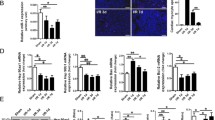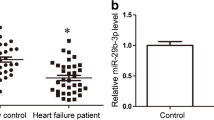Abstract
The protective effects of downregulated miR-199a-5p on ischemic and hypoxic cardiomyocytes were well recognized, but the underlying mechanism of inhibited miR-199a-5p is not yet clear. The present study explored the relationship between enhanced signal transducer and activator of transcription 3 (STAT3) signaling and lowered production of miR-199a-5p in hypoxic cardiomyocytes. This study firstly found the correlation between elevated interleukin (IL)-6 and IL-11, as well as subsequent STAT3 signaling activation and the downregulation of miR-199a-5p in hypoxic myocardial samples from children with congenital heart disease. Then, using model of hypoxic mice and the intervention of phosphorylated STAT3 (pSTAT3), it was observed that pSTAT3 affected the expression of miR-199a-5p and modulated the expression of its target genes, including endoplasmic reticulum stress (ERS)-related activating transcription factor 6 (ATF6) and 78 kDa glucose-regulated protein (GRP78). Further observation revealed that the pSTAT3 signal in cardiac tissue could affect the expression of pri-miR-199a-2, a precursor of miR-199a-5p. And the chromatin immunoprecipitation (ChIP) assay also confirmed that pSTAT3 could bind to the promoter region of miR-199a-2 gene, which is more significant under hypoxic conditions. In conclusion, the activation of STAT3 signaling in cardiomyocytes during chronic hypoxia leads to downregulation of miR-199a-5p, which promotes the expression of many downstream target genes. This is an important pathway in the adaptive protection mechanism of myocardium during hypoxia.



Similar content being viewed by others
References
Azzouzi HE, Leptidis S, Doevendans PA, De Windt LJ (2015) HypoxamiRs: regulators of cardiac hypoxia and energy metabolism. Trends Endocrinol Metab 26(9):502–508. https://doi.org/10.1016/j.tem.2015.06.008
Dai BB, Meng JR, Peyton M, Girard L, Bornmann WG, Ji L, Minna JD, Fang BL, Roth JA (2011) STAT3 mediates resistance to MEK inhibitor through MicroRNA miR-17. Cancer Res 71(10):3658–3668. https://doi.org/10.1158/0008-5472.CAN-10-3647
Dai BH, Geng L, Wang Y, Sui CJ, Xie F, Shen RX, Shen WF, Yang JM (2013) microRNA-199a-5p protects hepatocytes from bile acid-induced sustained endoplasmic reticulum stress. Cell Death Dis 4:e604. https://doi.org/10.1038/cddis.2013.134
Das A, Salloum FN, Durrant D, Ockaili R, Kukreja RC (2012) Rapamycin protects against myocardial ischemia-reperfusion injury through JAK2-STAT3 signaling pathway. J Mol Cell Cardiol 53(6):858–869. https://doi.org/10.1016/j.yjmcc.2012.09.007
Fineschi V (2015) Measuring myocyte oxidative stress and targeting cytokines to evaluate inflammatory response and cardiac repair after myocardial infarction. Curr Vasc Pharmacol 13(1):3–5
Gu Q, Kong Y, Yu ZB, Bai L, Xiao YB (2011) Hypoxia-induced SOCS3 is limiting STAT3 phosphorylation and NF-kappa B activation in congenital heart disease. Biochimie 93(5):909–920. https://doi.org/10.1016/j.biochi.2011.02.009
Ha M, Kim VN (2014) Regulation of microRNA biogenesis. Nat Rev Mol Cell Biol 15(8):509–524. https://doi.org/10.1038/nrm3838
Haghikia A, Missol-Kolka E, Tsikas D, Venturini L, Brundiers S, Castoldi M, Muckenthaler MU, Eder M, Stapel B, Thum T, Haghikia A, Petrasch-Parwez E, Drexler H, Hilfiker-Kleiner D, Scherr M (2011) Signal transducer and activator of transcription 3-mediated regulation of miR-199a-5p links cardiomyocyte and endothelial cell function in the heart: a key role for ubiquitin-conjugating enzymes. Eur Heart J 32:1287–1297. https://doi.org/10.1093/eurheartj/ehq369
Han Q, Yeung SC, Ip MS, Mak JC (2014) Cellular mechanisms in intermittent hypoxia-induced cardiac damage in vivo. J Physiol Biochem 70(1):201–213. https://doi.org/10.1007/s13105-013-0294-z
Hasnain SZ, Lourie R, Das I, Chen ACH, McGuckin MA (2012) The interplay between endoplasmic reticulum stress and inflammation. Immunol Cell Biol 90(3):260–270. https://doi.org/10.1038/icb.2011.112
Hassan T, Carroll TP, Buckley PG, Cummins R, O'Neill SJ, McElvaney NG, Greene CM (2014) miR-199a-5p silencing regulates the unfolded protein response in chronic obstructive pulmonary disease and alpha1-antitrypsin deficiency. Am J Respir Crit Care Med 189(3):263–273. https://doi.org/10.1164/rccm.201306-1151OC
He S, Liu S, Wu X, Xin M, Ding S, Xin D, Ouyang H, Zhang J (2016) Protective role of downregulated MLK3 in myocardial adaptation to chronic hypoxia. J Physiol Biochem 73(3):371–380. https://doi.org/10.1007/s13105-017-0561-5
Heather LC, Cole MA, Tan JJ, Ambrose LJ, Pope S, Abd-Jamil AH, Carter EE, Dodd MS, Yeoh KK, Schofield CJ, Clarke K (2012) Metabolic adaptation to chronic hypoxia in cardiac mitochondria. Basic Res Cardiol 107(3):268. https://doi.org/10.1007/s00395-012-0268-2
Hohensinner PJ, Niessner A, Huber K, Weyand CM, Wojta J (2011) Inflammation and cardiac outcome. Curr Opin Infect Dis 24(3):259–264. https://doi.org/10.1097/QCO.0b013e328344f50f
Hsu CY, Hsieh TH, Tsai CF, Tsai HP, Chen HS, Chang Y, Chuang HY, Lee JN, Hsu YL, Tsai EM (2014) miRNA-199a-5p regulates VEGFA in endometrial mesenchymal stem cells and contributes to the pathogenesis of endometriosis. J Pathol 232(3):330–343. https://doi.org/10.1002/path.4295
Jacoby JJ, Kalinowski A, Liu MG, Zhang SS, Gao Q, Chai GX, Ji L, Iwamoto Y, Li E, Schneider M, Russell KS, Fu XY (2003) Cardiomyocyte-restricted knockout of STAT3 results in higher sensitivity to inflammation, cardiac fibrosis, and heart failure with advanced age. Proc Natl Acad Sci U S A 100(22):12929–12934. https://doi.org/10.1073/pnas.2134694100
Jia YH, Zhou FH, Deng P, Fan Q, Li CH, Liu YW, Fu XQ, Zhou YC, Xu X, Sun XG (2012) Interleukin 6 protects H2O2-induced cardiomyocytes injury through upregulation of prohibitin via STAT3 phosphorylation. Cell Biochem Funct 30(5):426–431. https://doi.org/10.1002/cbf.2820
Lee C, Huang CH (2013) LASAGNA-Search: an integrated web tool for transcription factor binding site search and visualization. Biotechniques 54(3):141–153. https://doi.org/10.2144/000113999
Lee YB, Bantounas I, Lee DY, Phylactou L, Caldwell MA, Uney JB (2009) Twist-1 regulates the miR-199a/214 cluster during development. Nucleic Acids Res 37(1):123–128. https://doi.org/10.1093/nar/gkn920
Mathelier A, Fornes O, Arenillas DJ, Chen CY, Denay G, Lee J, Shi WQ, Shyr C, Tan G, Worsley-Hunt R, Zhang AW, Parcy F, Lenhard B, Sandelin A, Wasserman WW (2016) JASPAR 2016: a major expansion and update of the open-access database of transcription factor binding profiles. Nucleic Acids Res 44(D1):D110–D115. https://doi.org/10.1093/nar/gkv1176
Neri M, Fineschi V, Di Paolo M, Pomara C, Riezzo I, Turillazzi E, Cerretani D (2015) Cardiac oxidative stress and inflammatory cytokines response after myocardial infarction. Curr Vasc Pharmacol 13(1):26–36
Obana M, Maeda M, Takeda K, Hayama A, Mohri T, Yamashita T, Nakaoka Y, Komuro I, Takeda K, Matsumiya G, Azuma J, Fujio Y (2010) Therapeutic activation of signal transducer and activator of transcription 3 by interleukin-11 ameliorates cardiac fibrosis after myocardial infarction. Circulation 121(5):684–691. https://doi.org/10.1161/CIRCULATIONAHA.109.893677
Obana M, Miyamoto K, Murasawa S, Iwakura T, Hayama A, Yamashita T, Shiragaki M, Kumagai S, Miyawaki A, Takewaki K, Matsumiya G, Maeda M, Yoshiyama M, Nakayama H, Fujio Y (2012) Therapeutic administration of IL-11 exhibits the postconditioning effects against ischemia-reperfusion injury via STAT3 in the heart. Am J Phys Heart Circ Phys 303(5):H569–H577. https://doi.org/10.1152/ajpheart.00060.2012
Rane S, He M, Sayed D, Vashistha H, Malhotra A, Sadoshima J, Vatner DE, Vatner SF, Abdellatif M (2009) Downregulation of miR-199a derepresses hypoxia-inducible factor-1alpha and Sirtuin 1 and recapitulates hypoxia preconditioning in cardiac myocytes. Circ Res 104(7):879–886. https://doi.org/10.1161/CIRCRESAHA.108.193102
Sun XX, Zhang J, Hou ZH, Han QJ, Zhang C, Tian ZG (2015) miR-146a is directly regulated by STAT3 in human hepatocellular carcinoma cells and involved in anti-tumor immune suppression. Cell Cycle 14(2):243–252. https://doi.org/10.4161/15384101.2014.977112
Thuerauf DJ, Marcinko M, Gude N, Rubio M, Sussman MA, Glembotski CC (2006) Activation of the unfolded protein response in infarcted mouse heart and hypoxic cultured cardiac myocytes. Circ Res 99(3):275–282. https://doi.org/10.1161/01.RES.0000233317.70421.03
van Rooij E, Olson EN (2012) MicroRNA therapeutics for cardiovascular disease: opportunities and obstacles. Nat Rev Drug Discov 11(11):860–872. https://doi.org/10.1038/nrd3864
Wang M, Meng XB, Yu YL, Sun GB, Xu XD, Zhang XP, Dong X, Ye JX, Xu HB, Sun YF, Sun XB (2014) Elatoside C protects against hypoxia/reoxygenation-induced apoptosis in H9c2 cardiomyocytes through the reduction of endoplasmic reticulum stress partially depending on STAT3 activation. Apoptosis 19(12):1727–1735. https://doi.org/10.1007/s10495-014-1039-3
Zhang K, Kaufman RJ (2008) From endoplasmic-reticulum stress to the inflammatory response. Nature 454(7203):455–462. https://doi.org/10.1038/nature07203
Zhou Y, Jia WK, Jian Z, Zhao L, Liu CC, Wang Y, Xiao YB (2017) Downregulation of microRNA199a5p protects cardiomyocytes in cyanotic congenital heart disease by attenuating endoplasmic reticulum stress. Mol Med Rep 16(3):2992–3000. https://doi.org/10.3892/mmr.2017.6934
Funding
This work was supported by research grants from the National Natural Science Foundation of China (Nos. 81571842 and 81270228).
Author information
Authors and Affiliations
Corresponding authors
Ethics declarations
Conflict of interest
The authors declare that they have no conflict of interest.
Rights and permissions
About this article
Cite this article
Zhou, Y., Pang, B., Xiao, Y. et al. The protective microRNA-199a-5p-mediated unfolded protein response in hypoxic cardiomyocytes is regulated by STAT3 pathway. J Physiol Biochem 75, 73–81 (2019). https://doi.org/10.1007/s13105-018-0657-6
Received:
Accepted:
Published:
Issue Date:
DOI: https://doi.org/10.1007/s13105-018-0657-6




